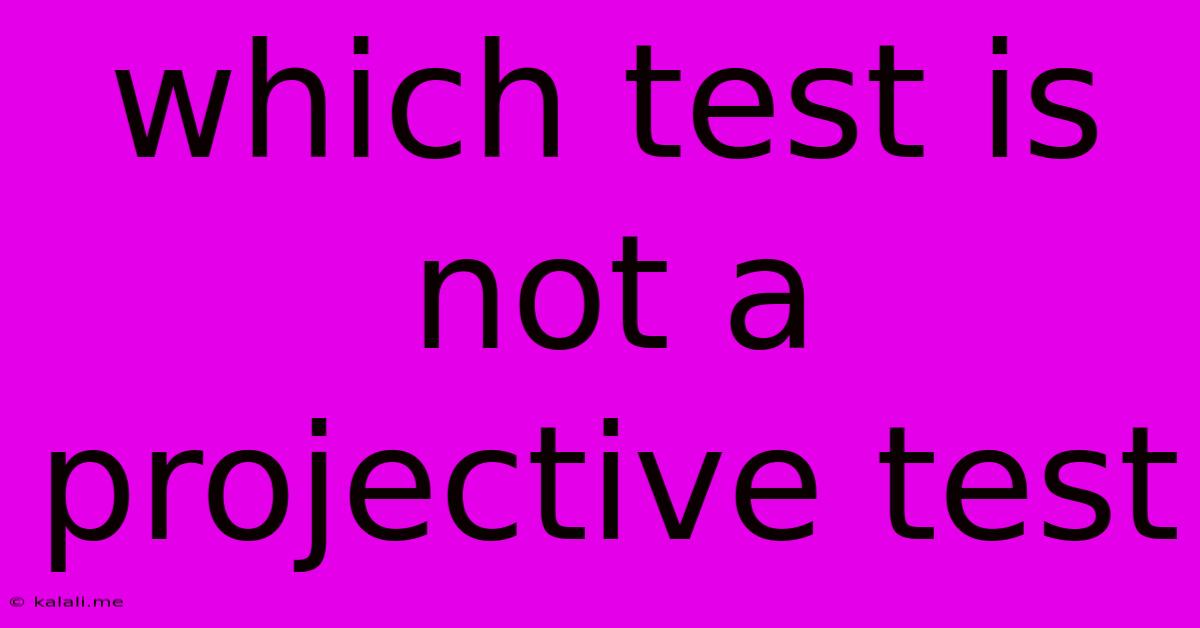Which Test Is Not A Projective Test
Kalali
Jun 13, 2025 · 3 min read

Table of Contents
Which Test is NOT a Projective Test? Understanding Projective vs. Objective Assessments
This article will explore the world of psychological testing, focusing on the distinction between projective and objective tests. We'll clarify what constitutes a projective test and, importantly, highlight examples of tests that are not projective. Understanding this difference is crucial for accurately interpreting psychological assessments and appreciating their diverse applications in clinical settings and beyond.
What are Projective Tests?
Projective tests are a category of psychological tests that present ambiguous stimuli to individuals, encouraging them to project their unconscious thoughts, feelings, and motivations onto the stimuli. The responses are then interpreted by a trained professional to gain insights into the individual's personality, dynamics, and underlying psychopathology. The ambiguity inherent in these tests allows for a wide range of responses, offering a window into the individual's unique perspective. Famous examples include the Rorschach Inkblot Test and the Thematic Apperception Test (TAT).
Key Characteristics of Projective Tests:
- Ambiguous Stimuli: The stimuli presented are not clear-cut or structured.
- Subjective Interpretation: Responses are open-ended and require subjective interpretation by a trained psychologist.
- Unconscious Projection: The goal is to uncover unconscious thoughts, feelings, and motivations.
- Qualitative Analysis: The analysis often focuses on qualitative aspects of responses, such as themes, emotional tone, and narrative structure, rather than purely quantitative scores.
Which Tests are NOT Projective Tests?
Conversely, many psychological assessments utilize a structured, objective approach. These tests are specifically designed to avoid ambiguity and rely on quantifiable data for interpretation. They tend to focus on readily observable behaviors and characteristics, yielding numerical scores that can be compared against established norms. Here are some examples:
-
Intelligence Tests (e.g., Wechsler Adult Intelligence Scale – WAIS, Stanford-Binet Intelligence Scales): These tests measure cognitive abilities such as verbal comprehension, perceptual reasoning, working memory, and processing speed. They use standardized questions and scoring procedures, producing a quantitative IQ score. The stimuli are unambiguous and the interpretation is largely objective.
-
Personality Inventories (e.g., Minnesota Multiphasic Personality Inventory – MMPI, NEO PI-R): These tests utilize self-report questionnaires with clearly defined questions and response options (e.g., Likert scales). They offer a structured assessment of various personality traits, often resulting in numerical scores representing different personality dimensions. The scoring is objective, and the interpretation relies on established norms and statistical analysis.
-
Neuropsychological Tests (e.g., Trail Making Test, Wisconsin Card Sorting Test): These tests assess cognitive functions related to brain structure and function. They use structured tasks with clear instructions and objective scoring systems, allowing for the identification of potential cognitive impairments.
-
Achievement Tests (e.g., standardized educational assessments): Designed to measure knowledge and skills acquired through education, these tests employ specific questions with correct answers, resulting in objective scoring and evaluation of performance.
The Importance of the Distinction:
Understanding the difference between projective and objective tests is crucial for several reasons:
- Appropriate Test Selection: Choosing the right test depends on the specific assessment goals. Projective tests are beneficial when exploring unconscious processes, while objective tests are better suited for measuring observable traits and cognitive abilities.
- Accurate Interpretation: Misinterpreting the nature of a test can lead to inaccurate conclusions. Objective tests require a different approach to interpretation than projective tests.
- Ethical Considerations: The use of projective tests requires specialized training and expertise in interpretation. Improper use can lead to misdiagnosis and ethical concerns.
In conclusion, while projective tests offer a valuable tool for exploring the depths of human psychology, many other assessment methods rely on objective, quantifiable data. Tests like intelligence tests, personality inventories, neuropsychological tests, and achievement tests fall squarely into the category of non-projective assessments, offering a contrasting but equally important approach to psychological evaluation. The choice of which test to utilize depends heavily on the specific research question or clinical need.
Latest Posts
Latest Posts
-
Which Of The Following Is Not A Protein
Jun 14, 2025
-
Which Of The Following Is Not A Money Market Security
Jun 14, 2025
-
Duvalls Developmental Stages Of The Family
Jun 14, 2025
-
Least Common Multiple Of 27 And 63
Jun 14, 2025
-
1 8 27 64 What Is The Next Number
Jun 14, 2025
Related Post
Thank you for visiting our website which covers about Which Test Is Not A Projective Test . We hope the information provided has been useful to you. Feel free to contact us if you have any questions or need further assistance. See you next time and don't miss to bookmark.